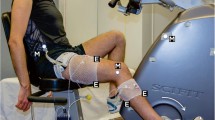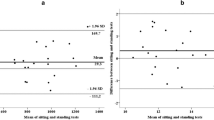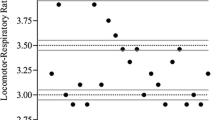Abstract
This study compared the rate of fatigue and lower limb EMG activities during high-intensity constant-load cycling in upright and supine postures. Eleven active males performed seven cycling exercise tests: one upright graded test, four fatigue tests (two upright, two supine) and two EMG tests (one upright, one supine). During the fatigue tests participants initially performed a 10 s all-out effort followed by a constant-load test with 10 s all-out bouts interspersed every minute. The load for the initial two fatigue tests was 80% of the peak power (PP) achieved during the graded test and these continued until failure. The remaining two fatigue tests were performed at 20% PP and were limited to the times achieved during the 80% PP tests. During the EMG tests subjects performed a 10 s all-out effort followed by a constant-load test to failure at 80% PP. Normalised EMG activities (% maximum, NEMG) were assessed in five lower limb muscles. Maximum power and maximum EMG activity prior to each fatigue and EMG test were unaffected by posture. The rate of fatigue at 80% PP was significantly higher during supine compared with upright posture (−68 ± 14 vs. −26 ± 6 W min−1, respectively, P < 0.05) and the divergence of the fatigue responses occurred by the second minute of exercise. NEMG responses were significantly higher in the supine posture by 1–4 min of exercise. Results show that fatigue is significantly greater during supine compared with upright high-intensity cycling and this effect is accompanied by a reduced activation of musculature that is active during cycling.





Similar content being viewed by others
References
Barstow TJ, Mole PA (1991) Linear and nonlinear characteristics of oxygen uptake kinetics during heavy exercise. J Appl Physiol 71:2099–2106
Beaver WL, Wasserman K, Whipp BJ (1986) A new method for detecting anaerobic threshold by gas exchange. J Appl Physiol 60:2020–2027
Beelen A, Sargeant AJ (1991) Effect of fatigue on maximal power output at different contraction velocities in humans. J Appl Physiol 71:2332–2337
Convertino VA, Goldwater DJ, Sandler H (1984) Oxygen uptake kinetics of constant-load work: upright vs. supine exercise. Aviat Space Environ Med 55:501–506
Denis R, Perry S (2006) Influence of posture on pulmonary O2 uptake kinetics, muscle deoxygenation and myolectrical activity during heavy-intensity exercise. J Sports Sci Med 5:254–265
Egaña M, Green S (2005) Effect of body tilt on calf muscle performance and blood flow in humans. J Appl Physiol 98:2249–2258
Egaña M, Green S (2007) Intensity-dependent effect of body tilt angle on calf muscle fatigue in humans. Eur J Appl Physiol 99:1–9
Egaña M, Green S, Garrigan EJ, Warmington S (2006) Effect of posture on high-intensity constant-load cycling performance in men and women. Eur J Appl Physiol 96:1–9
Egaña M, Smith S, Green S (2007) Revisiting the effect of posture on high-intensity constant-load cycling performance in men and women. Eur J Appl Physiol 99:495–501
Eiken O (1988) Effects of increased muscle perfusion pressure on responses to dynamic leg exercise in man. Eur J Appl Physiol Occup Physiol 57:772–776
Fitzpatrick R, Taylor JL, McCloskey DI (1996) Effects of arterial perfusion pressure on force production in working human hand muscles. J Physiol 495(Pt 3):885–891
Gandevia SC (2001) Spinal and supraspinal factors in human muscle fatigue. Physiol Rev 81:1725–1789
Green S, Smith N, Kerr G (2009) Electromyographic activities in lower limb muscles are temporally associated with the slow phase of oxygen uptake. Scan J Med Sci Sports. doi:10.1111/j.1600-0838.2009.00893.x
Hogan MC, Richardson RS, Kurdak SS (1994) Initial fall in skeletal muscle force development during ischemia is related to oxygen availability. J Appl Physiol 77:2380–2384
Koga S, Shiojiri T, Shibasaki M, Kondo N, Fukuba Y, Barstow TJ (1999) Kinetics of oxygen uptake during supine and upright heavy exercise. J Appl Physiol 87:253–260
Leyk D, Essfeld D, Hoffmann U, Wunderlich HG, Baum K, Stegemann J (1994) Postural effect on cardiac output, oxygen uptake and lactate during cycle exercise of varying intensity. Eur J Appl Physiol Occup Physiol 68:30–35
MacDonald MJ, Shoemaker JK, Tschakovsky ME, Hughson RL (1998) Alveolar oxygen uptake and femoral artery blood flow dynamics in upright and supine leg exercise in humans. J Appl Physiol 85:1622–1628
Tachi M, Kouzaki M, Kanehisa H, Fukunaga T (2004) The influence of circulatory difference on muscle oxygenation and fatigue during intermittent static dorsiflexion. Eur J Appl Physiol 91:682–688
Terkelsen KE, Clark AL, Hillis WS (1999) Ventilatory response to erect and supine exercise. Med Sci Sports Exerc 31:1429–1432
Conflict of interest statement
The authors of the present study declare that they have no conflict of interest.
Author information
Authors and Affiliations
Corresponding author
Additional information
Communicated by Arnold de Haan.
The experiments presented in the present study comply with the current laws of the Republic of Ireland.
Rights and permissions
About this article
Cite this article
Egaña, M., Ryan, K., Warmington, S.A. et al. Effect of body tilt angle on fatigue and EMG activities in lower limbs during cycling. Eur J Appl Physiol 108, 649–656 (2010). https://doi.org/10.1007/s00421-009-1254-8
Accepted:
Published:
Issue Date:
DOI: https://doi.org/10.1007/s00421-009-1254-8




